Is this the greatest place on Earth for birdwatching?
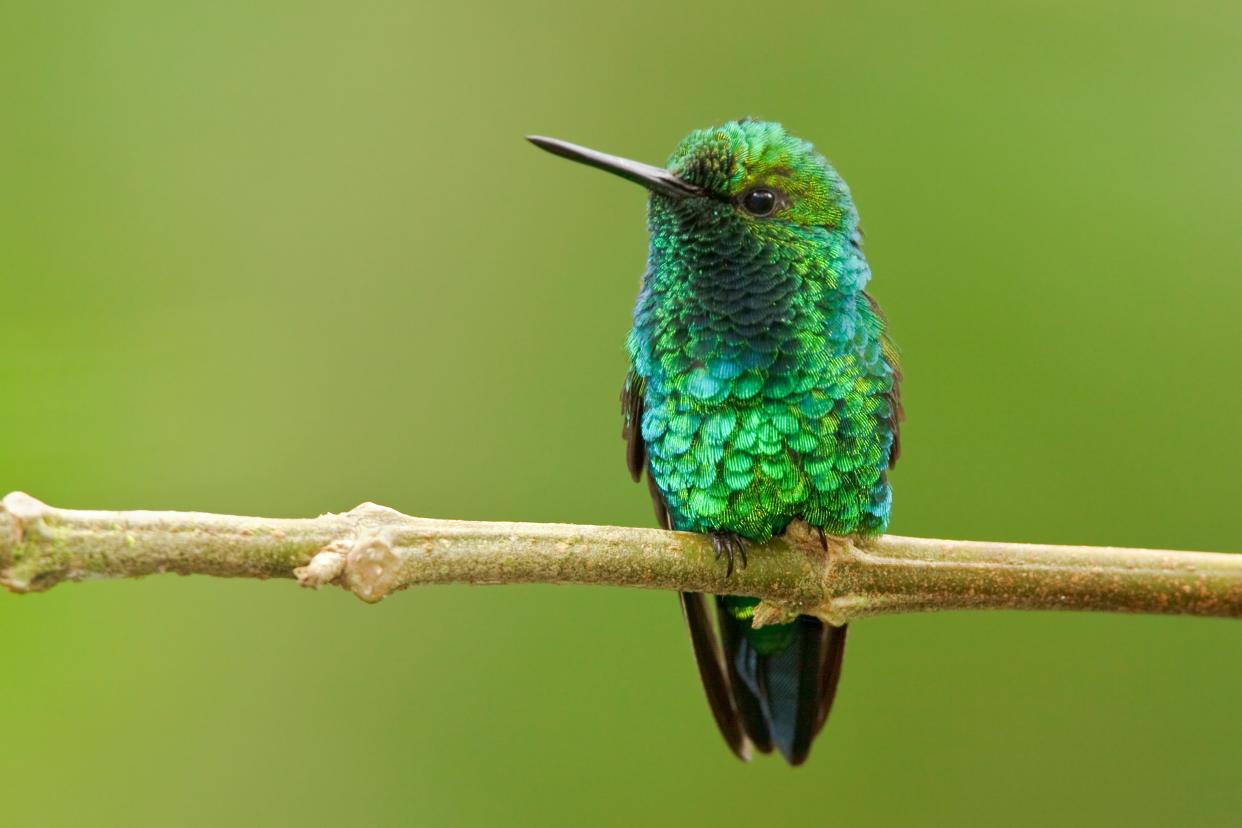
As we float through the air, my hand brushes through copious beards of sodden moss that droop from a brooding magnolia tree towards the cloud forest floor, a remote Lilliputian domain more than 200ft below. Above me, there is nothing but silky whiteness. But around me there is every imaginable shade of green, collectively housing myriad life forms that were previously unimaginable. At Mashpi Lodge, three hours north-west of the Ecuadorian capital, Quito, I am becoming part of the sylvan canopy – and disinterring a whole new world.
I have experienced rainforests before, but almost always from below – feet on terra firma, neck cricked, binoculars straining vertically towards lofty treetops. On occasion, I have scaled observation towers purporting to offer a parrot’s-eye view of forest life. But only at Mashpi have I truly been admitted to the rainforest canopy, thanks to its brand-new aerial gondola, “the Dragonfly” – an open cage that cruises for more than a mile (2km) through one of the world’s most wildlife-rich landscapes.
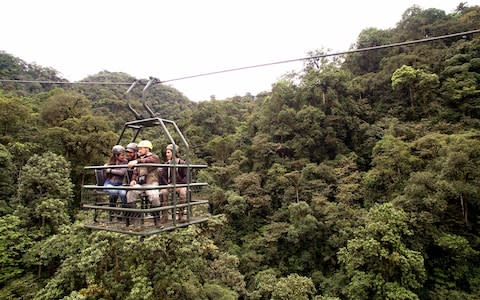
Such an innovative ecotourism offering comes at a price. The Dragonfly cost US$2 million (£1.5 million) and required almost two years to construct. But then Mashpi is a top-end “ecolodge”, among the privileged elite making up National Geographic’s Ultimate Lodges of the World. Count on paying more than a grand per night for a double room.

Mashpi’s exclusivity starts at its imposing entrance, where gargantuan bamboo gates deter unauthorised ingression. A uniformed security guard strides suspiciously towards our car, but is persuaded to check our names against the guest list – and grants us access. The descent to the lodge scrambles 1,300ft in altitude more than two-and-a-half miles (4km) of narrow, pitted track through almost untouched cloud forest. This is quite some driveway. We turn a final corner and Mashpi Lodge cleaves into view. Amid its primeval surroundings, however, the airy, cavernous steel-and-glass building is shocking. It could serve as the lair of a James Bond villain.
Any such notion is dispelled by the smiles and jugo de papaya that greet my arrival. Accompanying me along stone-floored corridors, past splashes of colour, Alfonso Diaz, operations manager, contextualises the lodge. Mashpi turns out to be a conservationists’ dream, not a criminal’s hideout.
At a glance | The 20 countries with the most species of bird
“Roque Sevilla was mayor of Quito,” he explains, “but he also brought the Worldwide Fund for Nature to Ecuador.” In 2001, Roque and his friends clubbed together to buy a forest the size of a town, sparing it from a logging concession and creating a private reserve. “Conservation has always been at the heart of Mashpi,” Alfonso says.
Carlos Morochz, a reserve biologist, nods his agreement. “If Roque had not purchased this land, there would be access roads everywhere and people removing the trees. The lodge saved the forest – and the forest was the reason for the lodge.”
Carlos takes time out from leading the reserve’s scientific programme to guide me around. “One of the joys of working here is deciding the research projects we run. We have surveyed birds, mammals, reptiles and amphibians – discovering creatures not known to live here, some even new to science. The more income the lodge generates from tourism, the more cloud forest mysteries we can unravel. My next goal is to study how hummingbirds pollinate flowers.”
The world's 17 greatest countries for animal lovers
Glancing outside through the floor-to-ceiling, wall-to-wall windows, I see why the cloud forest gets its name. Or, rather, I don’t see. The lodge has condensed to a bubble within a dense shroud of water vapour. Within the mist, what I remembered being trees when we arrived are now merely hints of bulbous shapes.
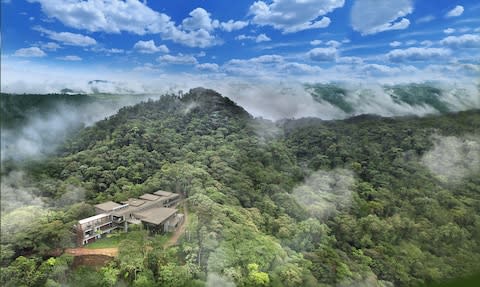
Mashpi lies in the Chocó forest, which uncoils from Quito into Colombia. The Chocó is defined by 20ft of annual rainfall, 10 times that of my home county of Norfolk. Mashpi is perpetually damp and frequently drenched; the name means “friend of water”, says Carlos. Water is the life force that enables trees to tower, swells leaves to the size of duvets, festoons boughs with bromeliads and brightens branches with a thousand types of orchid.
“There’s no point waiting for the drizzle to stop,” says José Napa, one of Mashpi’s naturalist guides. “It won’t.” Impressively athletic, José is among the 80 per cent of employees drawn from the local community. As shareholders in the lodge, they have a vested interest in its success. This is a paradigm shift for these people; most of them previously worked for logging companies, mustering a livelihood by chopping down trees, not revering them.
“I used to be a hunter and a logger,” admits José as we slush along twirling forest trails. “One day, two men from Quito arrived and said they wanted to preserve the forest rather than fell it.” José didn’t believe them. “So they invited me to join them in the forest and showed me beautiful orchids. I started to believe they were for real.” The men – sent by Roque Sevilla – offered José employment as a guardabosque (forest guard). “That month, they paid me $170. I had never held so much cash.” José has been working for Mashpi ever since.
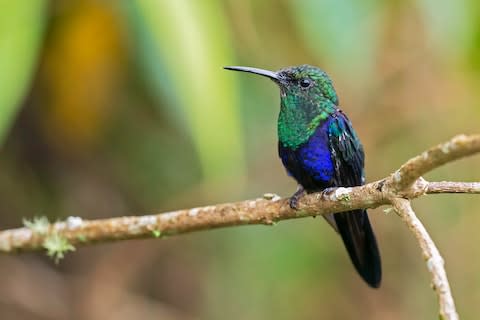
Continuing uphill, we reach Mashpi’s hummingbird feeders, where tiny aeronauts flit between plastic sugar dispensers mocked up as Day-Glo flowers. Every ecolodge in Ecuador has such feeders, typically around the accommodation so that visitors may gawp while relaxing. Mashpi, as I’m coming to appreciate, does things differently. Its hummingbird station is an hour’s stiff walk from the lodge, in tall forest. The views are as breathtaking as elsewhere – the rainbowed protagonists even zoom between us, their carbohydrate high vanquishing their habitual timidity – but the setting is more natural and the range of species greater. José reels off a seemingly never-ending list of evocative names: velvet-purple coronet, violet-tailed sylph, empress brilliant, Andean emerald...
Watching the chaos of hummingbirds is exhausting, so we retreat to the lodge for sustenance. Following a dip in the Jacuzzi and a massage, I take my pew in the cathedral of a dining room, revering a menu that fuses Ecuadorian tradition with Pacific flair. Tangy ceviche soup or carrot mousse? Rump steak or manioc-encrusted tuna? There’s also a papaya and naranjilla soufflé to finish. Spa treatments and fine dining in the rainforest? I could get used to this.

The following dawn, we regroup on a vast terrace. Yesterday’s mist has dissipated, unveiling a pleated panorama of forest-cloaked hills. We stroll downhill to Carlos’s pride and joy, a butterfly enclosure. Here, hand-sized butterflies hang from palms, aggressively flashing wings marked with an owl’s eyes.
Enchanted, we repair to a communal table. Breakfast is served – and not just ours either. For José has filled eye-level platforms in the sloping garden with over-ripe bananas, each bunch clouded by minute flies. It is also feeding time for Mashpi’s fruit-eating birds. As we nibble mango, papaya and melon, a swirl of gaudy visitors brightens our morning. A moss-backed tanager is partitioned in green, yellow and blue. A crimson-rumped toucanet flashes a fiery rear. A blue-tailed trogon swivels its head 270 degrees – at somewhere near sloth speed. In the midst of our lazy birdwatching, a loud roar echoes across the valley. Mantled howler monkeys, José says. They are living up to their name.
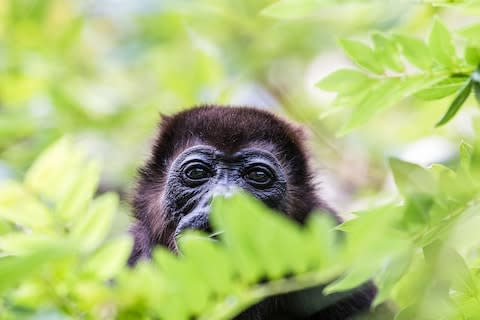
Back at the lodge, the 26ft-high windowpanes are splattered with irrepressibly coloured, erratically contoured moths. There are thousands – “attracted to overnight lights,” Carlos says. For anyone who dismisses moths as small, brown and garment munching, Mashpi’s entomological eye candy is a revelation. So immense and sharply angled is one moth that I mistake it for a boomerang. “That’s a hawkmoth,” giggles Carlos.
We are not alone in noticing the spectacle. The morass of moths provides an unmissable buffet for birds. There are wings everywhere. Antbirds and brush-finches slope out of the undergrowth to partake. Motmots and solitaires sit high then swoop low. My favourite is the long-wattled umbrella bird, which resembles a crow with a quiff.
The moths are also a clue that the cloud forest really comes alive at night. That evening, to reveal more, Carlos invites me out on a nocturnal walk. “Let’s look for frogs and snakes,” he says. “Prepare to get wet.” I heave on wellies and waterproof overtrousers. We are joined by a trendy-looking twentysomething. Lucas Bustamante just happens to have written the first field guide to Ecuador’s amphibians and reptiles. He is wearing sandals and a T-shirt. I feel overdressed.
We mooch along a streambed, headlamps illuminating the underside of palm fronds caressing the water. Our lights pick up an array of crickets, katydids and stick insects the length of my hand. A saucer-sized tarantula clings to a trunk. Frogs prove harder to find, but we soon spot several types. It helps that males are calling to attract females – a real-life frog chorus of chirrups, clicks and squealing exclamations. I am enchanted by a tiny lime-toned frog. “A glass frog!” says Carlos, excitedly. It’s another well-named animal: I can see bones through its translucent skin.
10 places in South America you never thought to visit
In this amphibian auditorium, there is one call that particularly excites my guides. In 2010, Carlos photographed a frog that he sensed was something different. Conferring with experts, he confirmed it as new for science, naming it Mashpi torrenteer in honour of the lodge. We locate a female, but the male remains elusive. The forest rarely reveals its entire hand.
It is only on our final day that we infiltrate Mashpi’s treetops. We warm up on the Sky Bike, a two-person pedalo that traverses 650ft of forested gorge along cables. It is the bicycle ride of a lifetime, suspended in mid-air, able to pause whenever a flock of birds passes around us.
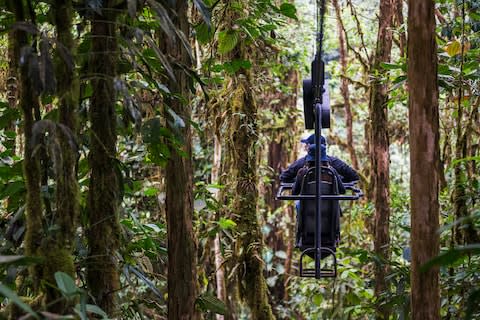
For the main act, we board the Dragonfly and soar – effortlessly, silently – below, above and through the cloud forest tops. As toucans honk and golden butterflies glitter, Carlos points out another species new for science. A thousand times larger than his torrenteer frog, it is a hitherto clandestine magnolia tree with spoon-shaped cream flowers. Growing solely at Mashpi, it was only discovered thanks to the Dragonfly that enabled Carlos to collect samples of leaves, flowers and fruits from the canopy. Mashpi is not only cloud nine for ecotourists, but for conservationists and scientists too.
Ecuador essentials
James Lowen visited Mashpi courtesy of Metropolitan Touring (00593 2298 8312; metropolitan-touring.com) and Quito Turismo (quito-turismo.gob.ec). Double rooms at Mashpi Lodge start at $1,437 (£1,079) full-board, including guiding. Read a full review of Mashpi Lodge.
Mashpi's star birds
Long-wattled umbrellabird
Black and crow-sized, the male’s wattle dangles like a feathered boa.
Rufous motmot
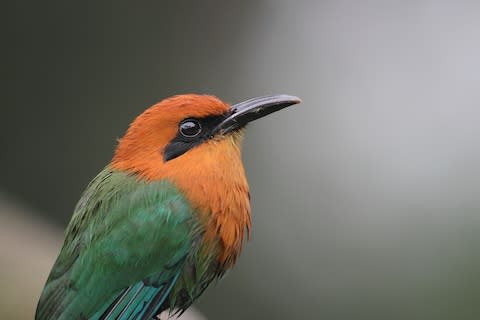
Recalls a colourful magpie, lissome and long tailed, above.
Velvet-black coronet
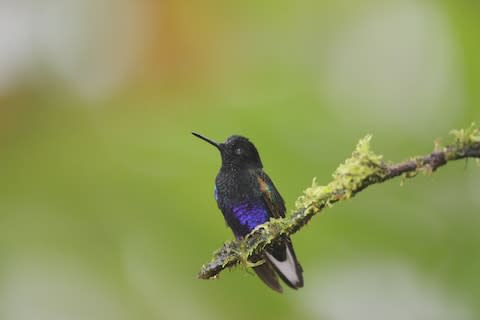
Mashpi’s speciality hummingbird, gleaming purple in sunlight.
Toucan barbet
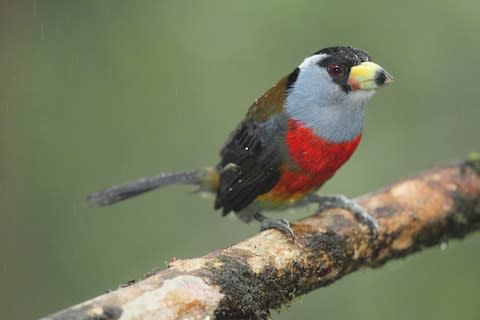
A clown dressed up as a multicoloured, big-billed bird, above.
Moss-backed tanager
A finch-sized fruiteater, rare elsewhere but abundant at Mashpi, below.

